On the final day of the group stage fixtures, South Korea had everything to play for, while Portugal were already guaranteed to progress into the next stage. At the Education City stadium, Portugal made their intentions clear, with a heavily rotated lineup, giving some of the players a chance to play their way into the starting lineup.
South Korea on the other hand, came into the game off the back of a 3-2 defeat to Ghana, which left them needing a win and hoping for Ghana to drop points in their grudge match against Uruguay, in order for them to stand a chance of progressing further.
In this tactical analysis, we take a detailed look at the tactics utilised by both South Korea and Portugal. There is an analysis of how Portugal dominated the ball, yet couldn’t create many chances after going 1-0 up, and resorted to attempts from outside the box pretty much exclusively.
Lineups
As Portugal had already qualified, Fernando Santos decided to give a few players minutes, and offer some key players a vital rest. Antonio Silva came in to replace Man City‘s Ruben Dias, to become the youngest-ever player to represent Portugal at the World Cup. Manchester United‘s Diogo Dalot replaced the injured Nuno Mendes who will miss the rest of the tournament, forcing Cancelo to move into left back.
In midfield, Neves retained his place, while Matheus Nunes, Wolves’ record signing, and Vitinha came into midfield to get some minutes in their legs. Both players could start for the stacked Portuguese team, but there is a lot of competition, and so Santos prefers to go for more experienced players in the important games.
In attack, Cristiano Ronaldo stays up front, after an injury worry. Ricardo Horta and Joao Mario come into the front line, replacing Joao Felix and Bruno Fernandes, who are like for like in the sense that they prefer the ball to feet, but lack the directness of the former pairing.
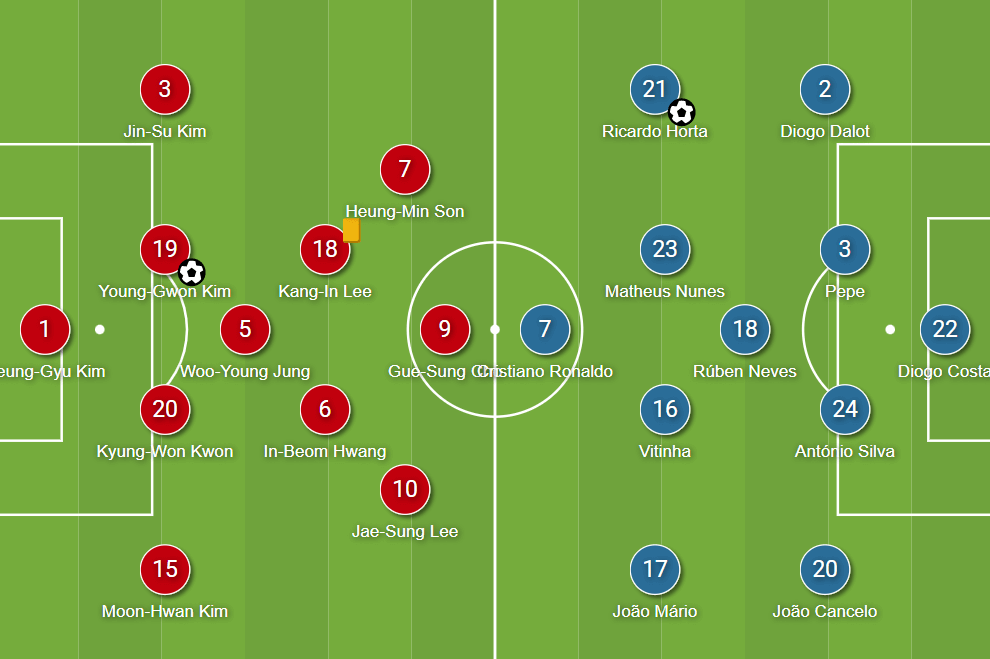
For South Korea, Kyung-Won Kwon comes into central defence, replacing Napoli’s Min-Jae Kim after he is a doubt due to injury. Kang-In Lee comes into the starting lineup, after securing an assist instantly after coming off the bench against Ghana. Jae-Sung Lee also comes into the lineup, to replace Chang-Hoon Kwon. Wolves’ Hee-Chan Hwang came on as a sub, to score the decisive winner to send South Korea into the knockout stage of the World Cup.
Portugal’s dominance
One of the reasons for Portugal maintaining 55% possession was their inconsistent attempts to press the ball. At times, Portugal were outnumbered, and so would attempt to block passing channels rather than proactively chase the ball. However, on occasion, Ronaldo would successfully cut off the pitch by forcing the centre back to one side, making it easier for the rest of the Portuguese players to get tight to the Korean players, to force them to go long.
While the Portuguese press was partly responsible for their domination of possession, they were also helped out by the Korean’s frequent attempts to play long balls into the striker, even when under minimal pressure.
Portugal would set up in a 4-4-1-1 off the ball, with either of the two CM’s stepping up to be just behind Ronaldo. In the image below, we can see Portugal’s press come to life. Ronaldo forces the defender to move to the right, thus cutting off the left-hand side of the pitch. The LM, Joao Mario, prevents the pass from reaching the RB. Ricardo Horta inverts from the right wing to mark the holding midfielder, whilst the CF, Vitinha, covers the other central defender.
This pressing structure wasn’t particularly effective as the distances were quite large, especially for the right winger. In the image, we can see that there is a clear passing lane to the holding midfielder as Horta hasn’t got there yet, but Korea’s defenders weren’t brave enough and lacked the vision to attempt the passes in tighter spaces. This sort of press would be easily played through, had they faced a more technical group of players.
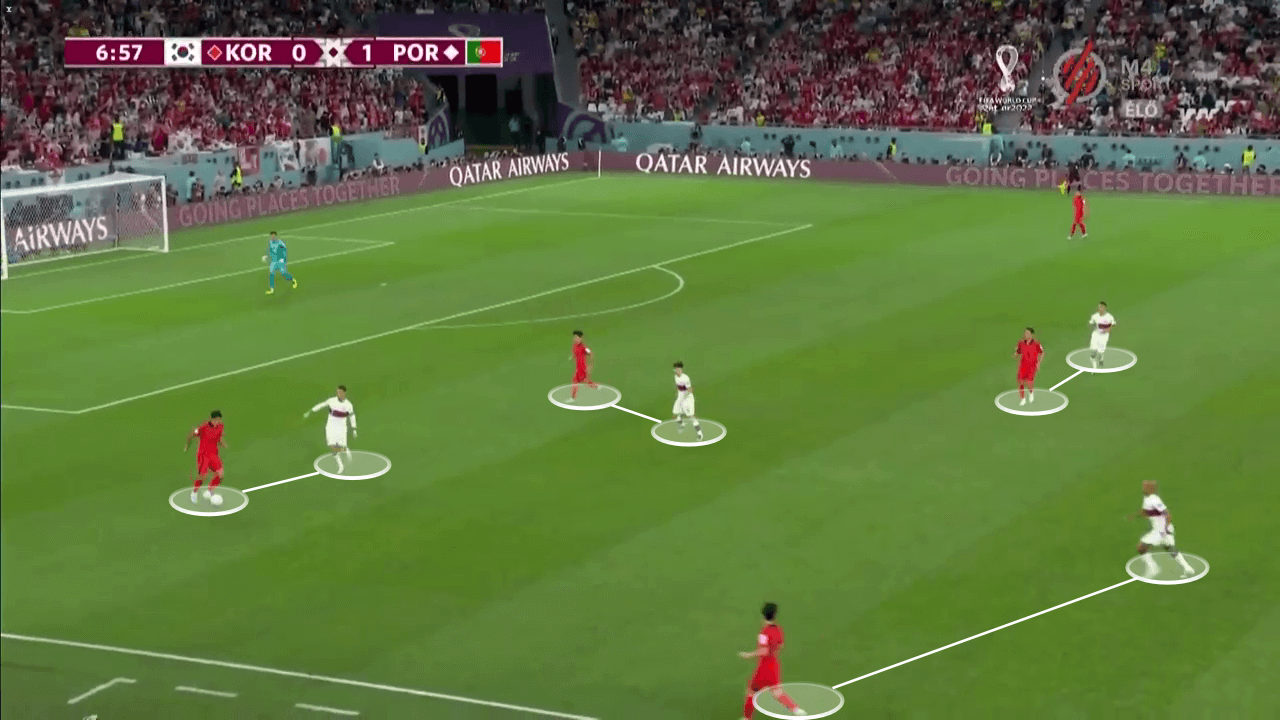
South Korea’s defensive shape was set up in a 4-5-1, which was compact vertically during their mid-block, but a lack of pressure made it easy for Portugal to retain the ball, and progress it. The lone striker would at times chase the ball, but Ruben Neves would simply drop deeper to offer a simple forward option for his centre-backs. During the times when an extra player would press the ball, another Portugal midfielder would drop deep to create the overloads.
A midfield line of Vitinha, Nunes and Neves is one which is technically secure, and has the press resistance to dribble their way out of trouble, should the passing options be limited. If this sort of technical quality isn’t pressed in an organised and aggressive manner, it becomes ineffective, and easy to play through. As a result, Kores decided to sit off them and prevent the space between the lines.
A problem with this approach became evident fairly quickly, as the moderately high line of South Korea, would often be penetrated through long diagonal balls in behind. The image below shows Korea’s defensive shape, and the high line with a lack of pressure on the ball can be catastrophic. Pepe has all the time in the world to execute his pass to perfection, whilst Diogo Dalot makes a darting run into the vast space behind the defensive line.
This made it extremely easy for Portugal to get into the final third, where they could pin Korea back and attempt to create goal-scoring chances. From the example below, Dalot carries the ball into the box, which results in a goal for Horta after a cutback.
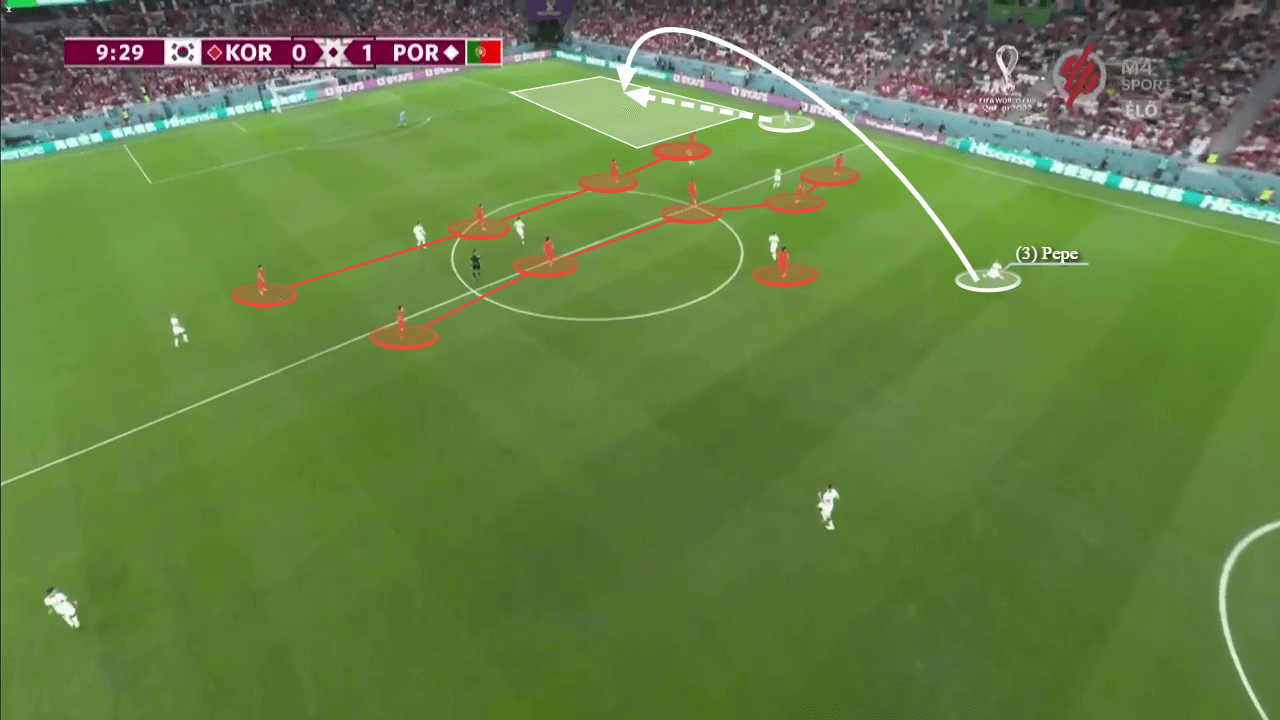
Pepe had lots of time on the ball through Korea’s reluctance to put pressure on the ball, and so he had lots of opportunities to play progressive passes to further forward players. The pass map below from the game shows that Pepe completed numerous long diagonal balls in behind the defence, for either fullback to run onto, whilst he also had a lot of passes going into the midfield line centrally, as a result of his line-breaking passing ability.
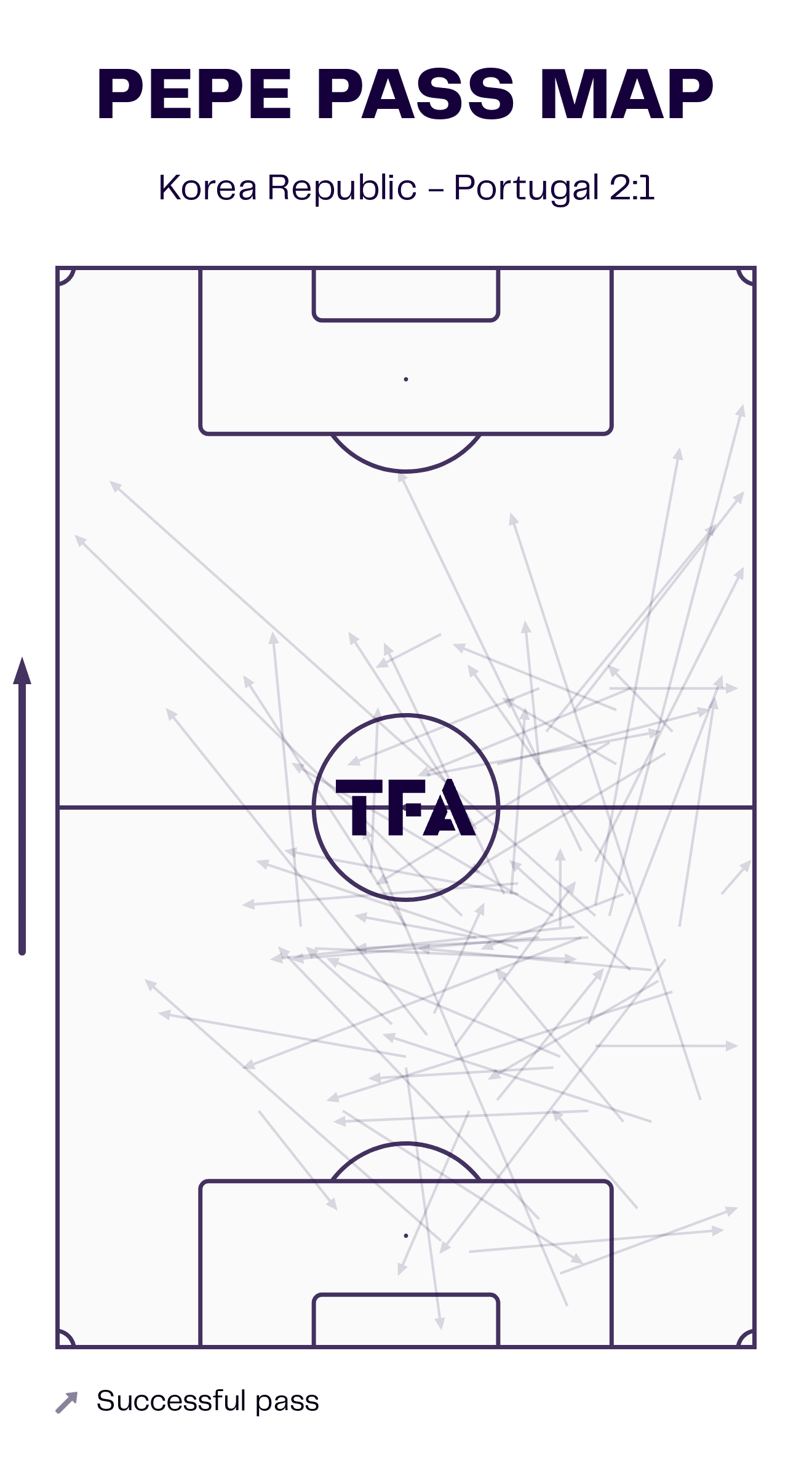
Ruben Neves is another player with an excellent passing range, who utilised his skillset to consistently switch play from side to side, to stretch the Korean defensive line. Neves played slightly higher than Pepe, so when had possession of the ball against their mid-block, the back line was slightly deeper.
While the space behind was slightly lesser, the Korean back line stayed narrow, which left plenty of space down the flanks. Neves exposed the space through his long diagonal balls, which often found both Cancelo and Dalot, who stayed wide and dribbled at their defenders.
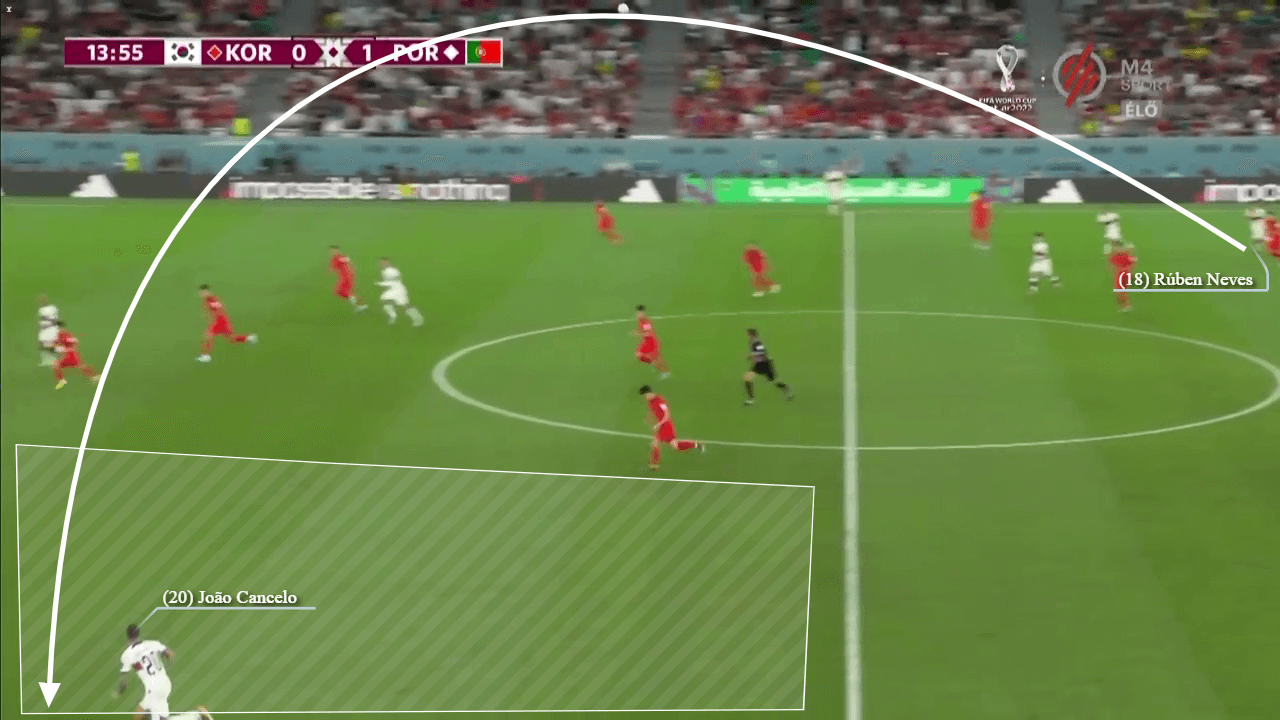
An issue Korea had with their defensive set-up, was that the central midfielders, who would step up to press the ball, would vacate the space in the midfield with no cover. When players pressed the ball from deep, they would often have no time to get to the ball in time, as it would be simply passed to the side, and the gaps left behind left the defence open and would be penetrated by the Portuguese players.
In the example below, we can see Vitinha run into the gap left behind between the Korean holding midfielder and right winger. Pepe has the passing ability to accurately play the ball, from where Vitinha can receive it facing the Korean defenders, and combine with his teammates to create a chance. This sort of opportunity didn’t happen often, as Korea were well drilled, which was important as Portugal had the technical ability to consistently make these passes.
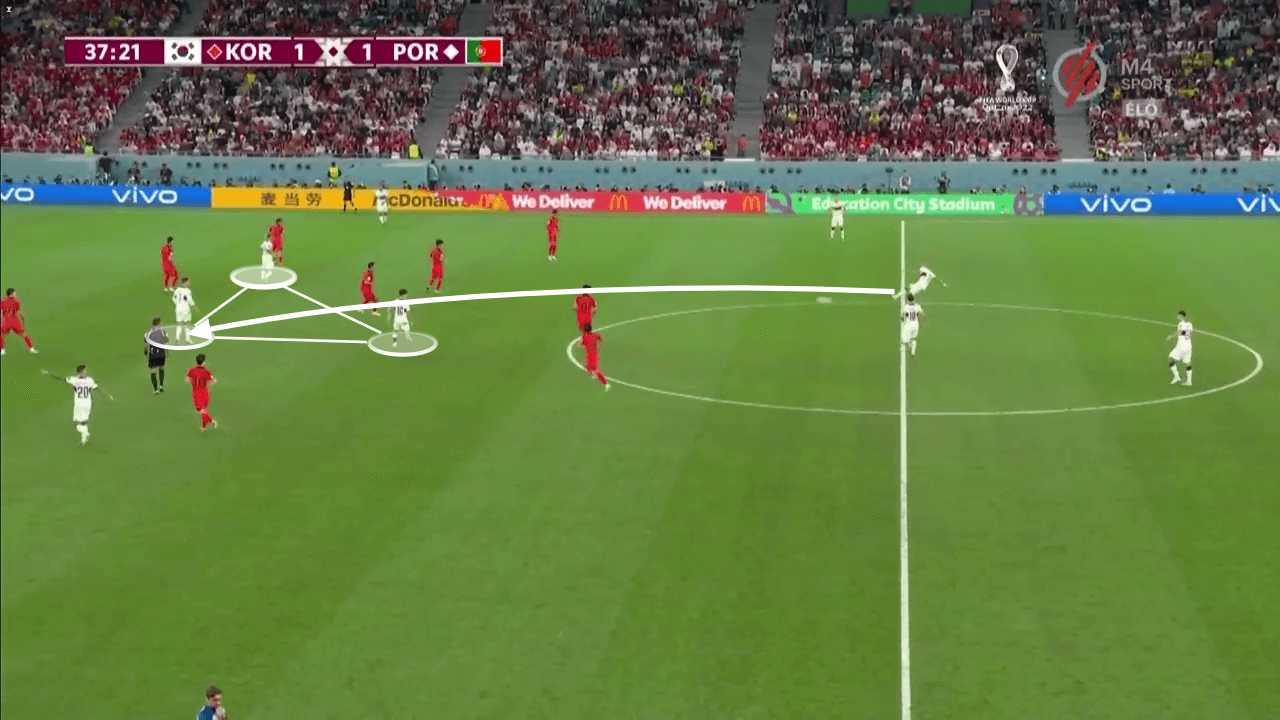
While the Portugal team was good in the build-up phases, they lacked rigidity in the final third. The inclusion of Mario and Horta meant that the Portuguese squad lacked balance. Dalot and Cancelo would always retain the width on either flank, but there was a lack of positional structure from the two attacking players, who often floated around looking to receive the ball.
Having a lack of structure in attack, meant that Portugal’s switches of play were sometimes ineffective, as the wide players had no one to combine with to progress the ball. The fullbacks would often be isolated and were forced to either play backwards or attempt to beat their man by themselves. Had the support been there, a simple one-two could have sufficed, but the attackers were never in the right places for these situations to come to light.
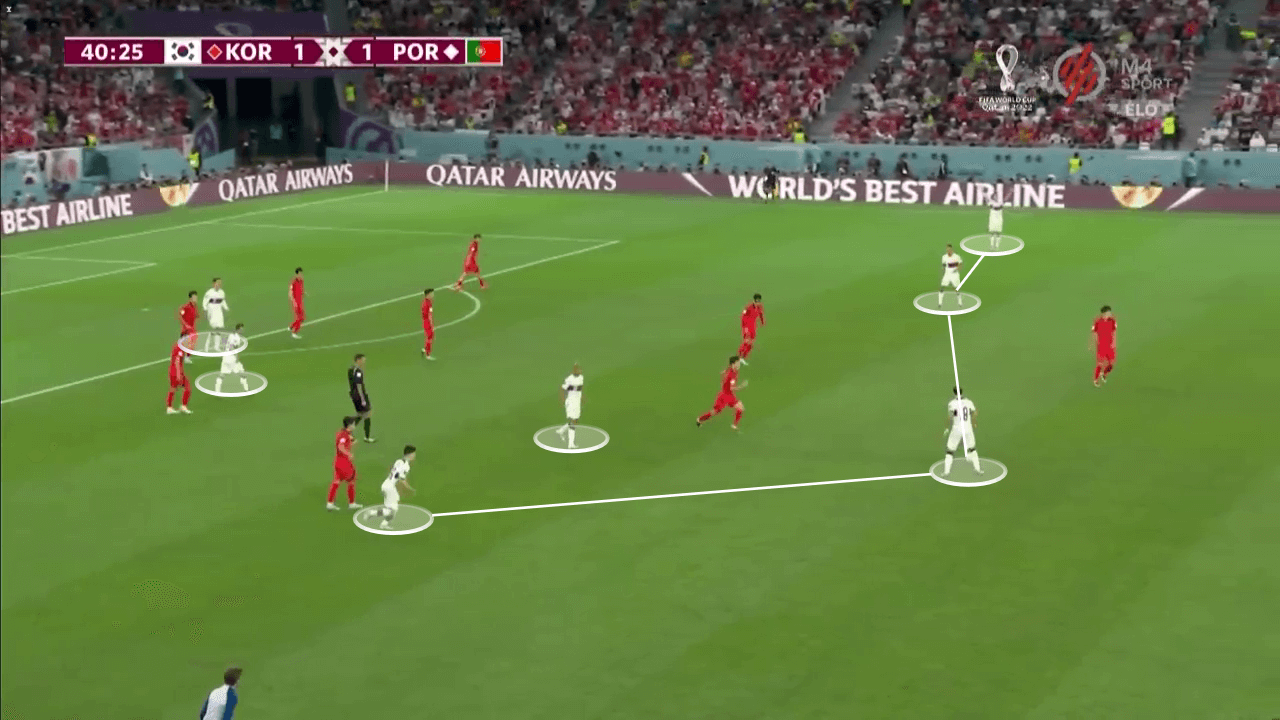
How Korea penetrated Portugal
On the other side, South Korea had 34% possession. Portugal’s press wasn’t particularly effective, so the low possession stat is South Korea’s own fault. They lacked the technical quality to be brave in possession, which played right into Portugal’s hands. South Korea would often resort to long balls into the final third, completely bypassing the middle third. While it may work in the sense that they reduce the risk of losing the ball in their own third, playing low-percentage balls so frequently can lead to a lack of control, which will limit your chances of winning matches.
We can see from the image below, that South Korea can have the quality to play out from the back. Portugal’s press often resulted in a free man in the second phase, but they were often overlooked as the ball was launched into the opposition’s half. In this exception, the ball is played quite low into the midfielder’s feet. As a result, South Korea successfully progress the ball past 5 players, which leads to a 5v5 in the opposite half. Being braver could have led to more goalscoring chances, but the long balls often ended up being won by Portugal’s defenders who would then build their attacks from the back.
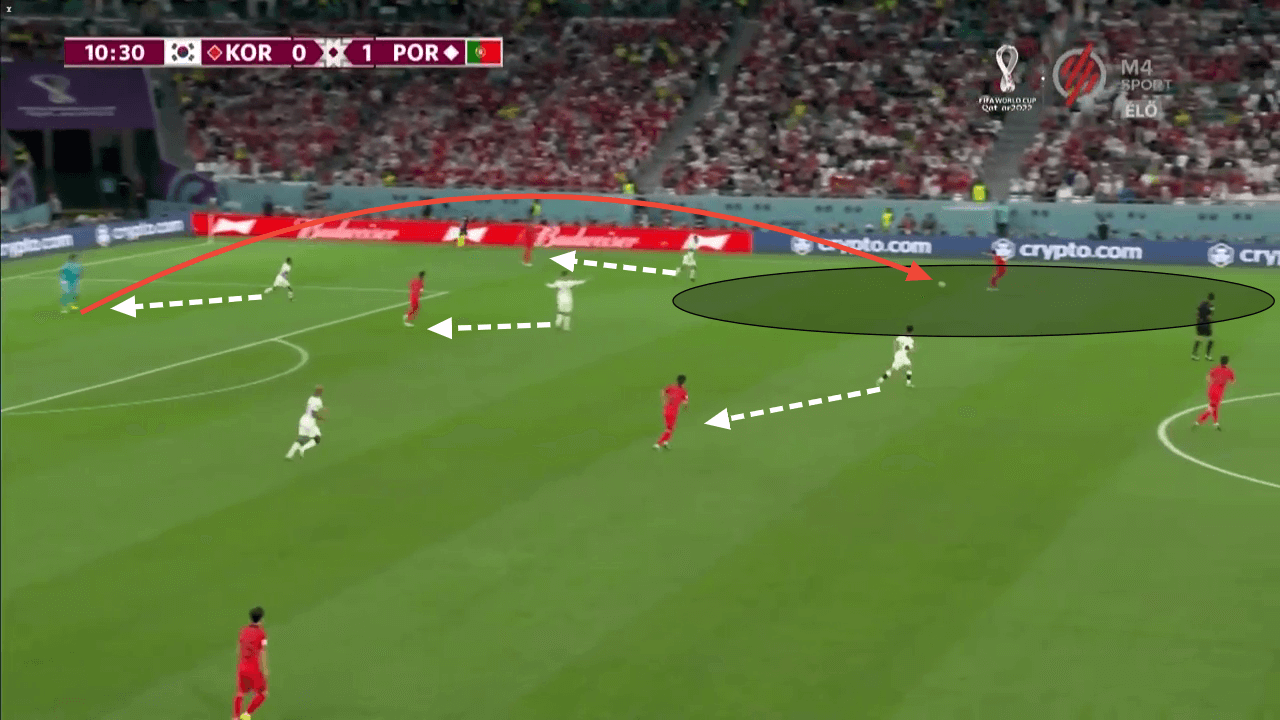
During Korea’s settled attacks, as limited as they may have been, were exciting to watch. There were many quick combinations of play to break down Portugal’s block, where they often penetrated in the wider areas. However, a lack of dribbling threat meant that Portugal’s fullbacks could win their 1v1 duels. Later in the game, Son started to drift to Cancelo’s side who is a weaker defender, and the winning goal comes from a Son assist from the right wing, albeit after a transition.
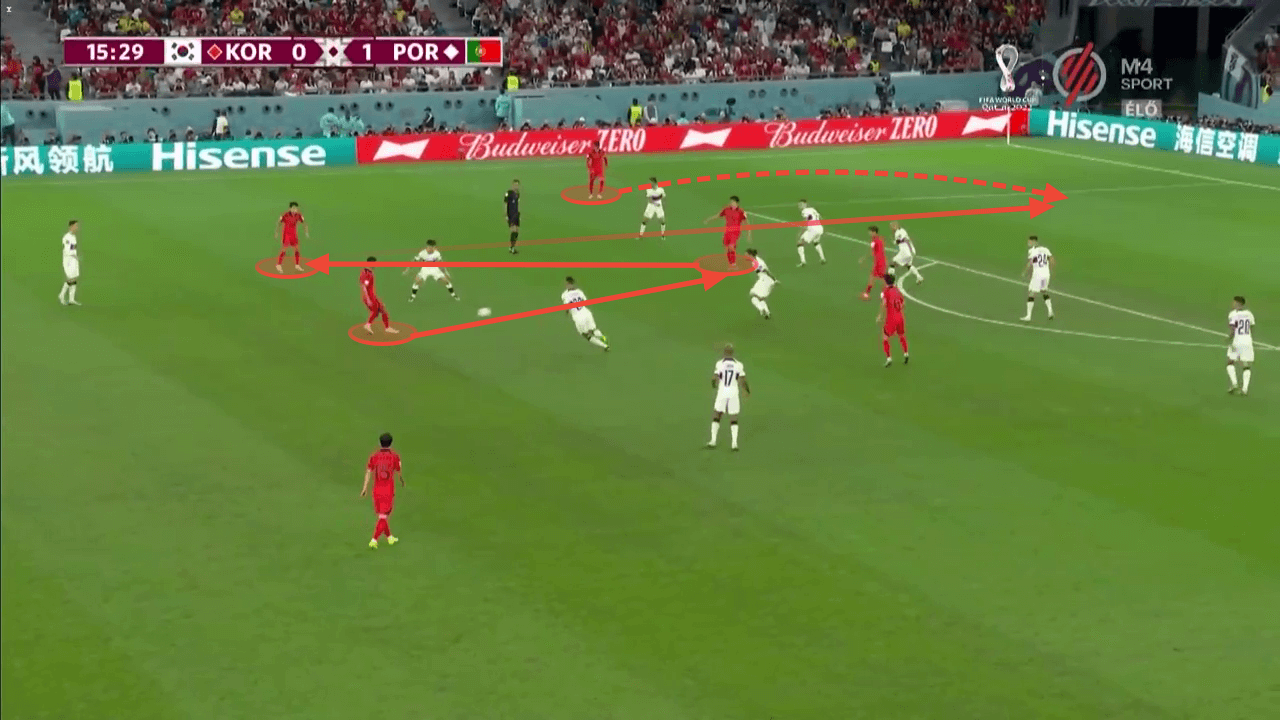
Conclusion
This tactical analysis highlights how South Korea eventually broke down Portugal’s defensive block. South Korea have shown some promising signs in their performances and should be proud of beating Portugal, but a lack of bravery on the ball, and some questionable decisions off the ball will likely see them fall short in their knockout match against Brazil.
Portugal on the other hand, with a weaker side, have shown some brilliant structural behaviours on the ball, and will likely see improved performances with the likes of Joao Felix, Rafael Leao or Bruno Fernandes returning to the side, but their lack of organisation off the ball could see them collapse at any moment.






Comments